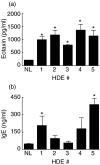Reproducibility of a novel model of murine asthma-like pulmonary inflammation
- PMID: 15086384
- PMCID: PMC1809026
- DOI: 10.1111/j.1365-2249.2004.02461.x
Reproducibility of a novel model of murine asthma-like pulmonary inflammation
Abstract
Sensitization to cockroach allergens (CRA) has been implicated as a major cause of asthma, especially among inner-city populations. Endotoxin from Gram-negative bacteria has also been investigated for its role in attenuating or exacerbating the asthmatic response. We have created a novel model utilizing house dust extract (HDE) containing high levels of both CRA and endotoxin to induce pulmonary inflammation (PI) and airway hyperresponsiveness (AHR). A potential drawback of this model is that the HDE is in limited supply and preparation of new HDE will not contain the exact components of the HDE used to define our model system. The present study involved testing HDEs collected from various homes for their ability to cause PI and AHR. Dust collected from five homes was extracted in phosphate buffered saline overnight. The levels of CRA and endotoxin in the supernatants varied from 7.1 to 49.5 mg/ml of CRA and 1.7-6 micro g/ml of endotoxin in the HDEs. Following immunization and two pulmonary exposures to HDE all five HDEs induced AHR, PI and plasma IgE levels substantially higher than normal mice. This study shows that HDE containing high levels of cockroach allergens and endotoxin collected from different sources can induce an asthma-like response in our murine model.
Figures





Similar articles
-
Eotaxin represents the principal eosinophil chemoattractant in a novel murine asthma model induced by house dust containing cockroach allergens.J Immunol. 2001 Sep 1;167(5):2808-15. doi: 10.4049/jimmunol.167.5.2808. J Immunol. 2001. PMID: 11509626
-
Reducing LPS content in cockroach allergens increases pulmonary cytokine production without increasing inflammation: a randomized laboratory study.BMC Pulm Med. 2011 Feb 23;11:12. doi: 10.1186/1471-2466-11-12. BMC Pulm Med. 2011. PMID: 21345191 Free PMC article.
-
Anti-tumor necrosis factor-alpha antibody treatment reduces pulmonary inflammation and methacholine hyper-responsiveness in a murine asthma model induced by house dust.Clin Exp Allergy. 2006 Jan;36(1):122-32. doi: 10.1111/j.1365-2222.2005.02407.x. Clin Exp Allergy. 2006. PMID: 16393274
-
House dust bioactivities predict skin prick test reactivity for children with high risk of allergy.J Allergy Clin Immunol. 2012 Jun;129(6):1529-37.e2. doi: 10.1016/j.jaci.2012.01.051. Epub 2012 Mar 3. J Allergy Clin Immunol. 2012. PMID: 22385634 Free PMC article.
-
Insights into endotoxin-mediated lung inflammation and future treatment strategies.Expert Rev Respir Med. 2018 Nov;12(11):941-955. doi: 10.1080/17476348.2018.1523009. Epub 2018 Oct 3. Expert Rev Respir Med. 2018. PMID: 30221563 Review.
Cited by
-
The Toll-like receptor 5 ligand flagellin promotes asthma by priming allergic responses to indoor allergens.Nat Med. 2012 Nov;18(11):1705-10. doi: 10.1038/nm.2920. Epub 2012 Oct 14. Nat Med. 2012. PMID: 23064463 Free PMC article.
-
A2B adenosine receptor expression by myeloid cells is proinflammatory in murine allergic-airway inflammation.J Immunol. 2012 Oct 1;189(7):3707-13. doi: 10.4049/jimmunol.1201207. Epub 2012 Sep 5. J Immunol. 2012. PMID: 22956582 Free PMC article.
-
Assessing pulmonary pathology by detailed examination of respiratory function.Am J Pathol. 2010 Oct;177(4):1861-9. doi: 10.2353/ajpath.2010.100053. Epub 2010 Aug 19. Am J Pathol. 2010. PMID: 20724595 Free PMC article.
-
Pulmonary inflammation and airway hyperresponsiveness in a mouse model of asthma complicated by acid aspiration.Comp Med. 2009 Aug;59(4):321-30. Comp Med. 2009. PMID: 19712571 Free PMC article.
-
Acute pulmonary lipopolysaccharide tolerance decreases TNF-alpha without reducing neutrophil recruitment.J Immunol. 2008 Dec 15;181(12):8402-8. doi: 10.4049/jimmunol.181.12.8402. J Immunol. 2008. PMID: 19050257 Free PMC article.
References
-
- Bernton HS, McMahon TF, Brown H. Cockroach asthma. Br J Dis Chest. 1972;66:61–6. - PubMed
-
- Rosenstreich DL, Eggleston P, Kattan M, et al. The role of cockroach allergy and exposure to cockroach allergen in causing morbidity among inner-city children with asthma [see comments] N Engl J Med. 1997;336:1356–63. - PubMed
-
- Chen G, Zhou D, Kang BC. A comparative study on cockroach and ovalbumin sensitizations and challenge responses in Hartley guinea-pigs. Respir Physiol. 2001;125:239–47. - PubMed
-
- Ernst P, Cormier Y. Relative scarcity of asthma and atopy among rural adolescents raised on a farm. Am J Respir Crit Care Med. 2000;161:1563–6. - PubMed
-
- Kramer U, Heinrich J, Wjst M, Wichmann HE. Age of entry to day nursery and allergy in later childhood. Lancet. 1999;353:450–4. - PubMed
Publication types
MeSH terms
Substances
Grants and funding
LinkOut - more resources
Full Text Sources
Other Literature Sources
Medical
Research Materials
Miscellaneous

